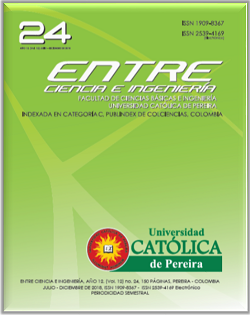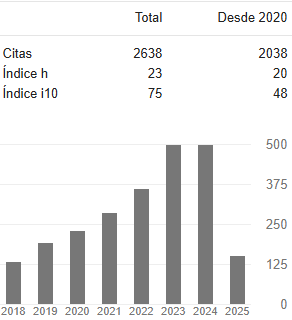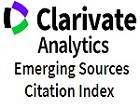Enrutamiento en redes de sensores inalámbricos usando algoritmos bioinspirados
DOI:
https://doi.org/10.31908/19098367.3823Palabras clave:
Algoritmos Bioinspirados, cobertura, conectividad, control de error, enrutamiento, métodos de optimización, nodos, redes de sensores inalámbricos, rendimiento, simulaciónResumen
Se presenta una solución para el problema de enrutamiento en una red de sensores inalámbricos utilizando inteligencia de enjambres, lo cual ha sido aplicado satisfactoriamente a otros problemas de enrutamiento, por ejemplo, el problema del agente viajero, entre otros. El enrutamiento en una red de sensores inalámbricos puede ser entendido como un problema de optimización. En la solución presentada, existe un nodo origen y un nodo destino. El problema está enfocado en encontrar las rutas que permita conectar un par de nodos de manera óptima. El espacio de búsqueda es el conjunto de posibles rutas que conectan esos dos nodos. Se implementaron dos algoritmos bioinspirados para el enrutamiento: un algoritmo basado en hormigas y otro algoritmo basado en abejas. Los resultados muestran que los algoritmos Bioinspirados mejoran el rendimiento en una red de sensores inalámbricos, considerando aspectos como la cantidad de energía disponible en los nodos. Las simulaciones muestran que se produce una mejora en el tiempo de vida de la red.
Descargas
Referencias
I. Mohammad y M. Imad, Handbook of Sensor Networks:Compact Wireless and Wired Sensing Systems, London: CRC Press Boca Raton, 2004.
I. Akyildiz y M. Can Vuran, Wireless Sensor Nerworks, United Kingdom: Wiley, 2010.
O. H. Mondragon Martínez y Z. M. Solarte Ataíza, «Architecture for the Creation of Ubiquitous Services Devoted to Health,» Entre Ciencia e Ingeniería. , vol. 5, nº 10, pp. 9-23, 2011.
N. Aakvaag y J. Frey, «Redes de sensores inalámbricos,» Revista ABB, vol. 4, nº 2, pp. 39--42, 2006.
H. M. Ahmad Fahmy, Wireless Sensor Networks, Singapure: Springer, 2016.
D. Rocha, D. A. Lopez Sarmiento y E. Gómez Vargas, «Los sistemas Bioinspirados y su enfoque en lasolución de necesidades en la Ingeniería,» REDES DE INGENIERIA, vol. 1, nº 2, pp. 22-29, 2012.
M. Gong, L. Pan, T. Song y T. Zhang, Bio-inspired Computing – Theories and Applications, Singapore: Springer Singapore, 2016.
E. Bonabeau, M. Dorigo y G. Theraulaz, Swarm Intelligence: From Natural to Artificial Systems, New York: JASSS, 1999.
M. Lopez-Ibanez y T. Stutzle, «The Automatic Design of Multiobjective Ant Colony Optimization Algorithms,» IEEE Transactions on Evolutionary Computation, vol. 16, nº 6, pp. 861-875, 2012.
M. Dorigo y T. Stützle, Ant Colony Optimization, United States: Massachusetts Institute of Technology, 2004.
W. Alfonso, M. Muñoz, J. Lopez y E. Caicedo, «Optimización de funciones inspirada en el comportamiento de búsqueda de néctar en abejas,» de Memorias del Congreso Internacional de Inteligencia Computacional (CIIC2007), Cali, 2007.
M. Paone, L. Paladina, D. Bruneo y A. Puliafito, «A Swarm-based Routing Protocol for Wireless Sensor Networks,» de Network Computing and Applications, 2007. NCA 2007. Sixth IEEE International Symposium on, United States, 2007.
J. Chen, R. Lin, Y. Li y Y. Sun, «LQER: A Link Quality Estimation based Routing for Wireless Sensor Networks,» Sensors, vol. 8, nº 2, pp. 1025-1038., 2008.
N. Latiff, C. Tsimenidis y B. Sharif, «Energy-Aware Clustering for Wireless Sensor Networks using Particle Swarm Optimization,» de Personal, Indoor and Mobile Radio Communications, 2007. PIMRC 2007. IEEE 18th International Symposium on, United States, 2007.
C. Beltrán y C. Franco, «Wireless Sensor Networks,» Bit, vol. 2, nº 165, pp. 61-64, 2007.
R. Hidalgo y J. Moreno, «Routing Design in Wireless Sensor Networks and a Solution for Healthcare Environment,» IEEE Latin Am. Trans, vol. 9, nº 1, pp. 353-359, 2011.
I. Akyildiz, W. Su, Y. Sankarasubramaniam y E. Cayirci, «Wireless sensor networks: a survey,» Computer networks, vol. 38, nº 4, pp. 393-422, 2002.
A. Mainwaring, D. Culler, J. Polastre, R. Szewczyk y J. Anderson, «Wireless sensor networks for habitat monitoring,» de Proceedings of the 1st ACM international workshop on Wireless sensor networks and applications, New York, 2002.
A. Kaur y K. Guneet, «Enhanced ECC Algorithm for Energy Efficient Code,» 2017 4th International Conference on Signal Processing and Integrated Networks (SPIN), pp. 459-462, 2017.
J. Aguilar y A. Labrador, «Un Algoritmo de enrutamiento Distribuído para redes de comunicación basado en sistemas de hormigas,» IEEE Latin America Transactions, vol. 5, nº 8, pp. 616-625, December 2007.
J. C. Blandón y J. A. López, «Bio-Route: un simulador para redes de sensores inalámbricos,» Revista Educación en Ingeniería, vol. 7, nº 3, pp. 23-31, 2012.
J. T. Serna, REDES DE SENSORES INALÁMBRICAS, Valencia España: Biblioteca Universitat de Valencia, 2007.
Crossbow, Wireless Sensor Networks, San Jose, California: Crossbow Technology. Inc, 2007.
Descargas
Publicado
Número
Sección
Licencia
Derechos de autor 2019 Entre Ciencia e Ingeniería

Esta obra está bajo una licencia internacional Creative Commons Atribución-NoComercial 4.0.



















